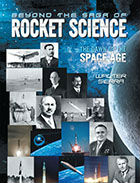
 |
The first in a series of four books covering the birth, development, and future of man’s journey into space, this volume covers the earliest history of rocketry as developed by the ancient Chinese with their “fire arrows” used in combat, eventually incorporating gunpowder as an accelerant. The Wright brothers’ momentous engine-driven first flight by humans is covered as is the further development by Robert Goddard. Theodore von Karman’s experimentation with solid fuel rocketry first applied to airplanes and later to missiles, is also explored. A discussion of Soviet and American advances sandwich a pivotal discussion of the German-led V-1 and V-2 rocket missile projects. Hitler’s eventual exclusive devotion to these destructive missiles contributed to Germany’s defeat, but the American and Russian capture of German rocket technology jumpstarted both countries’ space programs. Werner von Braun’s dedication to the American space program emerges as one the biggest factors in the winning of the race to the moon.
This is a beautifully constructed volume with innumerable photographs and illustrations on almost every page, many in color. The meticulous and detailed attention to the gradual progress of humanity toward space flight is expertly described by the author, a man with four decades in the aerospace and defense arenas. He provides biographical sketches of the pivotal figures in this field, from the Wright Brother’s lifelong bachelorhood to Robert Goddard’s disinterest in helping other rocket scientists’ research. The moral question of ex-Nazi scientists being brought over to work on American NASA projects is also discussed. An attempt to describe, in non-technical terms, the dynamics of aerodynamics is also present. Drag, lift, dynamic and static pressure, the Magnus effect, as well as the mystery of turbulence, are discussed. In short, this is an excellent overview of modern technology told in accessible and exciting language.
RECOMMENDED by the US Review